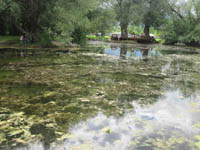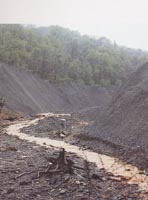UPCOMING EVENTS
View full calendarNutrients

There are many nutrients naturally occurring in the environment and are necessary for life. Nitrogen and phosphorus are available in the largest amounts. Learn more below.
Nitrogen
|
Utah Standards for Nitrogen
Maximum concentration of Nitrate in drinking water: 10 mg/L
Greater than 4 mg/L in surface water indicates pollution
|
Natural influences that cause nitrogen concentrations to change in water:
Seasonal changes
- In Utah concentrations are usually highest in the springtime when runoff from melting snow carries nutrients from lawns, farms and other areas into the water. Many people in Utah get their culinary water from groundwater from cities or private wells. Groundwater has naturally higher concentrations of nitrate.
- Plant uptake-during the spring and summer months plants grow causing concentrations of nitrates to below during this time. In the winter and fall, when plants stop growing and die, much of the nitrogen is released into the water again, increasing the nitrogen concentration.
Human influences that cause nitrogen concentrations to change in water:
- fertilizers
- livestock manure
- malfunctioning septic systems
- discharge from sewage facilities acid precipitation


Why care about nitrogen? Environment EnvironmentWhen waterways become over fertilized with nitrogen there can be heavy plant growth. Excessive plant growth can decrease the aesthetic value of the water because of the smelly decomposing mats of vegetation. Also, when bacteria decompose dead plant material they use up dissolved oxygen which is important for the survival of macroinvertebrates and other aquatic organisms.
Human Health High concentrations of nitrate in drinking water can cause methemoglobinemia (also known as blue baby syndrome). Concentrations greater than 10 parts per million can be harmful to young babies, and should be avoided by nursing mothers. Find out more about nitrate.
Concentrations of nitrate over 100 parts per million are toxic to livestock. Nitrates
are odorless, colorless, and tasteless so it is important to test feed and drinking
water to determine levels of nitrate.
Find out more about nitrate.
What is being done to minimize nitrogen related problems? See Nutrient Pollution Policy and Data |
Nitrogen Cycle (for more information click here)
|
|
Phosphorus
|
Utah Standards for Phosphorus
Concentrations of 0.05mg/L or above in a stream or river indicates pollution.
Concentrations of 0.025mg/L or above in a lake indicates pollution.
|
 Seasons-during spring runoff (or when flows are high) sediment concentrations can
be high. Phosphorus attaches to sediment, so this may cause the water to have a higher
concentration of phosphorus as well.
Seasons-during spring runoff (or when flows are high) sediment concentrations can
be high. Phosphorus attaches to sediment, so this may cause the water to have a higher
concentration of phosphorus as well.
- logging

- building activities
- overgrazing in riparian zone
- removal of riparian vegetation
- runoff from fertilizers
- poorly functioning septic tanks
- waste management treatment plants
Why care about phosphorus?
 Phosphorus is often the nutrient that limits how much plant growth occurs in a stream,
lake or reservoir. Therefore, adding a small amount of phosphorus may cause excess
plant growth. When these plants die, huge mats of decaying plants create odor and
aesthetic problems. When the plants in lakes and reservoirs die, more oxygen may be
used in the decomposition process than can be replaced. Without sufficient oxygen
fish and macroinvertebrates will die. Also, certain types of microscopic algae can be toxic if they reach very
high concentrations. Animals such as dogs or livestock that drink from these toxic
water bodies can become sick or die.
Phosphorus is often the nutrient that limits how much plant growth occurs in a stream,
lake or reservoir. Therefore, adding a small amount of phosphorus may cause excess
plant growth. When these plants die, huge mats of decaying plants create odor and
aesthetic problems. When the plants in lakes and reservoirs die, more oxygen may be
used in the decomposition process than can be replaced. Without sufficient oxygen
fish and macroinvertebrates will die. Also, certain types of microscopic algae can be toxic if they reach very
high concentrations. Animals such as dogs or livestock that drink from these toxic
water bodies can become sick or die.
Phosphorus Cycle

For more information see Understanding Your Watershed: Phosphorus.

